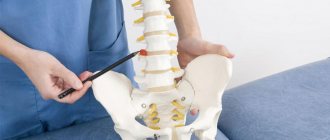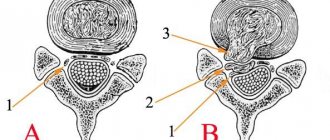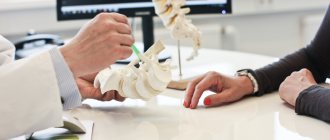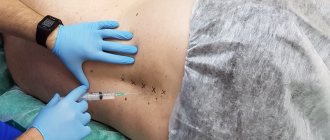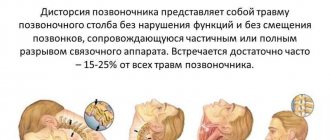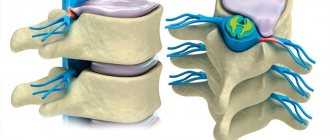- Home >
- Directory >
- Which doctor treats intervertebral hernia
In the absence of adequate treatment, degenerative changes in the intervertebral discs, or osteochondrosis, sooner or later lead to the formation of an intervertebral hernia. This pathology is quite often accompanied by a whole complex of unpleasant symptoms, which often force the sufferer to ask the question: which doctor treats intervertebral disc herniation?
What is a herniated disc?
Intervertebral hernia is a pathological process in the spine, which is caused by the presence of a destructive-degenerative course in the intervertebral discs . In this case, the bone tissue of the vertebrae is subject to destruction, the structure of the intervertebral disc is deformed, or the cartilage tissue of the fibrous ring is ruptured, and the nucleus pulposus of the disc is displaced away from the axis of the spinal column.
The nucleus pulposus falls out due to degenerative-destructive changes in the intervertebral disc
Destructive processes of this kind are predominantly formed in the lumbosacral spine , less often in the cervical spine. Intervertebral hernia of the thoracic region is quite rare due to the low mobility of the region itself, as well as the static retention of the amplitude of movement by the rib frame.
The development of a hernia formation can take a long time. Systematic loads on the spine, a sedentary lifestyle, a lot of fatty and high-calorie foods in the diet and other factors can provoke the development of destructive processes that not only cause increasing pain, but also negatively affect the mobility of the entire spine, as well as the functioning of internal organs.
How to sleep with a vertebral hernia
Since it so happens that the terrible diagnosis has been confirmed, then it makes sense to start treatment as soon as possible and change your lifestyle. For example, find out how to sleep if you have a vertebral hernia.
If you want to learn in more detail how to identify a spinal hernia, as well as consider the main signs of the disease and treatment methods without surgery, you can read an article about this on our portal.
Step 1. If you have a vertebral hernia, it is best to sleep on your side. In this case, the load on the affected disk will be less. You can get into the fetal position using a body pillow.
Sleep on your side
Step 2. Sleeping on your stomach is not recommended. This is the worst sleeping position for a person suffering from a herniated disc.
Don't sleep on your stomach
Step 3. You need to purchase a small pillow that can be placed under your knees while sleeping on your back. That is, you need to sleep with your legs slightly bent.
Buy a pillow for your knees
Step 4. You need to buy a mattress that is firm enough to support your spine. Soft mattresses are unsuitable for sleeping in this case.
Buy a firm mattress
Step 5. It is advisable to spend money on a special pillow equipped with a neck cushion to support it. In this case, the load on the spine will be minimal.
Neck pillow
Step 6. You should go to bed only when signs of drowsiness appear. In this case, a person will toss and turn less during sleep.
Go to bed only if you are feeling sleepy
Video - 5 main signs of a hernia
A vertebral hernia is a dangerous disease, but it is not a death sentence. It is quite possible to lead an almost normal life with it if it is identified and treated in time. By the way, in some cases the hernia can be cured completely.
Symptoms of a spinal hernia
Most often, signs of a hernia begin to be felt when the destruction of the intervertebral disc begins . Depending on which part of the pathological process occurs, the symptoms of the disease are slightly different. However, the first symptom of malfunction of the spinal column due to the occurrence of a hernia is, at the initial stages of development, mild pain, and over time, acute pain in the area where the pathological process is localized.
Symptoms of a hernia in the cervical spine
A hernia in the cervical spine is more dangerous than those that form in other parts of the spinal column. This is due to the fact that all the blood vessels and nerve plexuses leading to the head are concentrated in the cervical region.
Disc protrusion in the neck area is very dangerous, since there are a large number of plexuses of blood vessels and nerves in this area
Important! An enlarged hernia and pinched blood vessels in the cervical spine can not only disrupt the blood supply to the brain, but also lead to complete paralysis. Therefore, if any of the symptoms of a cervical hernia appear, you should undergo an examination. A hernia in the cervical spine can cause a stroke.
Symptoms of a cervical hernia are:
- discomfort, inability to always turn your head painlessly;
- inability to lower your head until your chin touches your chest without muscle tension and a pulling sensation in the neck;
- systematic headaches;
- previously non-occurring high blood pressure;
- numbness of the fingertips and upper extremities;
- systematically occurring dizziness;
- severe fatigue, craving for sleep;
- nausea, vomiting;
- memory impairment.
With the development of a hernia (its enlargement), increased pain and worsening symptoms are possible.
Symptoms of a hernia in the thoracic region
With a hernia in the thoracic region, pain occurs in the area of the shoulder blades or just below. A hernia in the thoracic region most often occurs in women, and then in isolated cases.
Symptoms of a thoracic hernia are:
- continuous pain in the area just below the shoulder blades or in the chest (chest);
- pain may be accompanied by numbness in the area where the hernia is located;
- pain in the heart area when moving, which is not relieved by medications against heart pain.
Most often, a thoracic hernia develops with scoliosis, the presence of curvature of the spine.
A thoracic hernia can also occur during pregnancy.
Symptoms of a hernia in the lumbar region
Did you know that...
Next fact
The lumbar region is the most vulnerable to the development of destructive processes due to its mobility and the load it can withstand. Often, lumbar intervertebral hernia is the result of sedentary work, irrational physical activity, and may be associated with obesity.
Symptoms of a lumbar intervertebral hernia are:
- pain in the lumbar region that occurs constantly or systematically;
- pain syndrome is accompanied by shooting in the leg, in the femoral region;
- numbness in the arms, legs, tingling of the fingertips;
- when moving, turning, straightening, the pain increases, limits mobility, reduces the amplitude of movement;
- as the hernia enlarges, the pain can spread to the knees, lower legs, and feet;
- disruption of the functioning of the digestive organs (diarrhea, constipation) due to compression of the spinal cord.
The lumbar spine is most vulnerable to the development of hernias
Symptoms of a herniated disc may be similar to symptoms of other pathological processes in the spine , so for an accurate diagnosis it is advisable to contact a specialist.
Video: “MRI scans of lumbar hernia”
Pay attention to the following articles:
- Gymnastics by Sergei Bubnovsky for hernia of the lumbar, cervical and thoracic spine
- Find out how a herniated disc is treated using conservative methods by going here
- To find out whether it is possible to take a steam bath with a hernia in the spine, follow the link
How dangerous is the disease?
Correct diagnosis and timely treatment of herniated intervertebral discs allows you to avoid such serious consequences as:
- disorder of the heart muscle,
- gastritis,
- chronic colitis,
- radiculitis,
- Chronical bronchitis,
- cerebral circulatory disorders,
- decreased sensitivity and paralysis of the limbs.
Contact a medical doctor and you will receive qualified medical assistance in the diagnosis and treatment of diseases such as osteochondrosis and herniated intervertebral discs.
Hardware methods for diagnosing spinal hernia
Diagnosis of intervertebral hernia using special equipment is carried out on the basis of patient complaints, after a visual examination and palpation of the affected area.
Hardware methods for diagnosing hernia include:
- radiography . Helps detect changes in the structure of bone tissue of destructively developing vertebrae, identifies possible injuries to the vertebrae, their congenital or acquired anomalies, the degree of displacement;
- CT scan . The method involves x-ray irradiation of different layers of tissue. Determines the nature of disc displacement, possible narrowing of the spinal canal, is an insufficiently informative method, but in combination it is almost always necessary;
- magnetic resonance imaging (MRI) . It is characterized as the most informative method for diagnosing a hernia: it determines not only destructive processes, the size of the hernia, its location and structure, but also reveals the degree of damage and pinching of nerve endings, compression of the vertebral roots, pathologies in the structure of the peridiscal tissues;
- electroneuromyographic study . Helps determine the speed of the impulse carried through the spinal canal. Evaluates the degree of displacement of a pathologically developing disc.
Hardware diagnostics is the most accurate method for identifying a hernia in the spine, allowing you to determine the stage and localization of the pathology
Modern hardware diagnostics can reveal not only the location of the intervertebral hernia, but also assess the degree of its growth, the condition of the fibrous ring, vertebrae, and possible pinching of nerve endings .
Most often, several hardware diagnostic methods are used to obtain a more accurate picture of the disease. Based on the results, the doctor assesses the severity of the disease and prescribes appropriate therapy.
Diagnosis of hernia at home
Self-diagnosis of an intervertebral hernia can be conditional, since an intervertebral hernia requires a comprehensive examination. The reason for determining the disease is most often pain syndrome (constant pain or temporary, systematic pain).
If you suspect an intervertebral hernia, you can perform a number of tests, after which in any case you should consult a doctor:
- most often, if there is a hernia, the patient does not sit on a chair straight, but takes the most comfortable position (even if this means bending slightly);
- When moving, the pain intensifies, when resting it subsides;
- pain spreads to the limbs;
- When turning or bending, the pain intensifies, especially when returning to the starting position.
Important! Self-diagnosis of an intervertebral hernia can only be a suspicion of the nature of the disease. For a clearer picture of the disease, you should consult a doctor.
Pain in the spine itself, not associated with temporary fatigue, occurring systematically and complicating movement can cause not only the development of an intervertebral hernia, but also other destructive processes.
In addition, if a hernia is present, it must be treated in order to prevent serious problems with the motor ability of the spine and the entire musculoskeletal system.
Video: “How to treat intervertebral hernia?”
Self-diagnosis
It is important to remember that it is impossible to independently determine the presence of a hernia with high accuracy - one can only assume the development of pathology. So the information below is for informational purposes only.
- Palpation and examination - doctors do the same thing, but they know what, where and how to look. They usually notice a reflex contraction of the back muscles.
- Behavior - you need to observe how you want to sit or lie down. Sometimes poses can be completely unnatural; a person takes them in order to reduce pain or discomfort. Also, all the patient’s movements will be smooth and accurate.
- Nature of pain. For example, the pain is aching - there is no compression of the nerve roots. Here it is just relevant to use the table above.
How to identify an intervertebral hernia yourself
